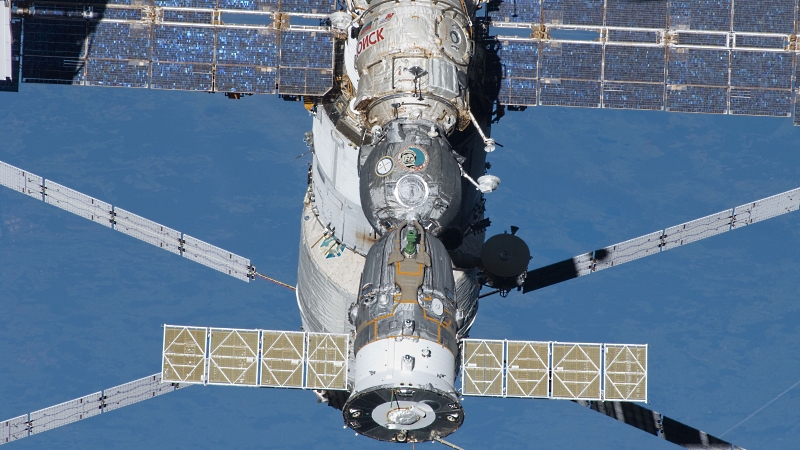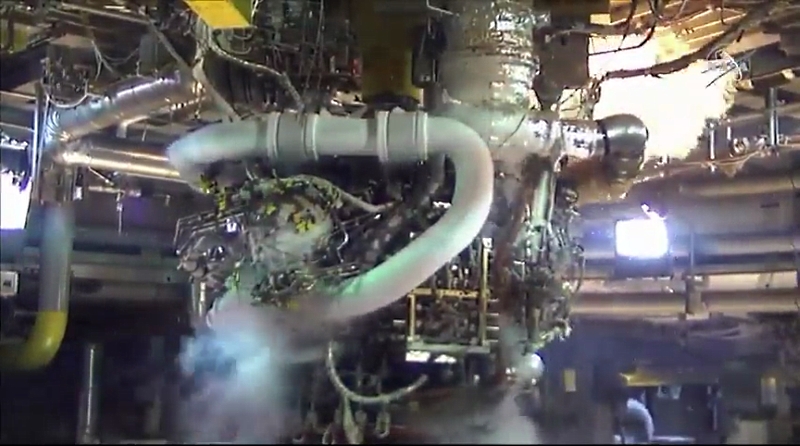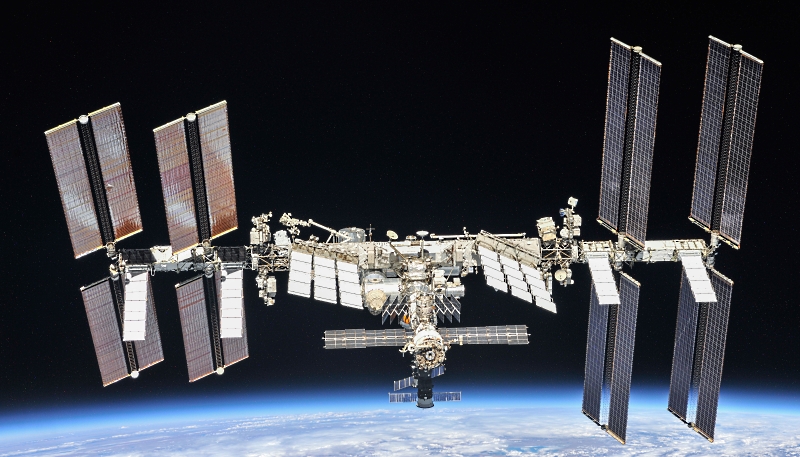NASA buys two more places on Soyuz, tests RS-25 and does not refuse the near-earth station
Last week, there were some interesting news about manned space flight. NASA is going to buy two more places on the "Unions", despite the almost finished Dragon 2 and Starliner. Successfully passed the test engine RS-25 for SLS after the December accident. And in the published document on how to reduce the ISS from the orbit in the future, there are lines about what happens, despite plans to create a near-moon Gateway station, NASA is not going to abandon the station in near-earth orbit, and without interruption after the ISS flooding.

Union, docked to the ISS, in the background are visible solar panels ATV, 2011, photo by NASA
Despite the fact that American astronauts will have to fly to the ISS on as many as two models of American ships this year, NASA continues to buy new seats on the Russian Soyuz. Additional two seats are planned to be purchased at Soyuz MS-15 and -16, autumn 2019 and spring 2020. The recommendation was given by the Aerospace Safety Advisory Panel (ASAP), and NASA listened to it. According to current plans, the command chair is given to Russian citizen Oleg Skripochka at the Soyuz MS-15, American Christopher Cassidy will have to take the second lodgment, and the third place was reserved for the UAE astronaut not yet named. It should be transplanted to one of the following ships. On the "Union MS-16" so far occupied two places, so the addition of the third will cause a minimum of problems.
A document published February 13 states:

Символическая гонка Dragon 2 и Starliner к МКС, изображение Nathan Koga/Nasaspaceflight.com
Despite the fact that the first unmanned test flight of the Dragon 2 has been in a state of “well, almost now very soon” for several months, it has not yet received all launch permits. This week will be a review of airworthiness (Flight Readiness Review), which can be given a "green light", and a list of comments to be eliminated with a second review. So, the date of the first flight of the SpaceX ship on March 2, mentioned now, is used exclusively with the prefix "no earlier than" and will almost certainly be shifted. For a Boeing ship, the timing is even more uncertain. An unmanned launch is expected not earlier than April-May, and a manned one is expected not earlier than August (quite possibly, much later). In addition, before a manned flight, both ships must pass another important test - the test of an emergency rescue system in flight, which for Dragon 2 is expected in June, and in Starliner in May. The situation of the latter is complicated by the changes made to the structure after the problems discovered last year (the capsule may start to tumble, which is potentially dangerous for the crew).
Eliminating the almost inevitable technical problems after test flights can move the launch dates indefinitely, so extending the guaranteed presence of American astronauts on the ISS with the help of Soyuz until autumn 2020 looks quite reasonable.
A light note of absurdity in the document makes an appeal to "interested organizations" to send their proposals for the delivery of astronauts to the ISS - China for political reasons are not allowed to the ISS, so Roscosmos, which for some reason did not want to be directly mentioned, remains the only "interested organization".

The test shot, NASA photo
on December 12, 2018, the next tests of the RS-25 engine for the super-heavy SLS launch vehicle had to be stopped already in the thirtieth second - the fire at the top of the engine is clearly visible in the frames. Fortunately, it turned out to be relatively small and did not spread quickly, so that in order to avoid damage to the engine and the test bench, the engine was manually stopped.
Eight days later, the results of the investigation were published - the cause of the fire was the leakage of hydrogen gas from a bench pressure transducer located near the engine. It is curious that, despite the shortened test time, many goals were achieved. The fact that they did not have time to check, was transferred to tests 1037, conducted on February 13, 2019.
The test was successful. This was the eighth test of stage 1b ( here we have more details about the different stages) of the planned nine. It tested a new engine controller, a combustion chamber made by hot isostatic pressing, and a damper of longitudinal ("pogo") vibrations printed on a 3D printer. Also, the engine was tested at a maximum thrust of 113% (at the time of the shuttles, thrust did not rise above 104.5%) and the minimum 80% attainable at ground level without a special diffuser (with a diffuser can be reduced to a minimum flight 65%).

New combustion chamber, photo Aerojet Rocketdyne

Damper, printed by selective laser sintering, photo Aerojet Rocketdyne

ISS October 4, 2018, photo NASA / Roscosmos
Large space projects with a lifespan of decades suggest that plans are made for years to come. And, in spite of the fact that now there is no understanding, until what year the ISS will work, plans for its reduction from orbit have already been worked out at a fairly detailed level. In 2016, a joint meeting of NASA and Roskosmos was held, at which specific details were clarified, and the opportunity to deactivate the ISS from orbit, as expected, should have appeared in 2017. In the event of a serious accident, the crew leaves it, and within 14 days a decision is made to flood the station. For 180 days, the station gradually loses altitude, and Roskosmos launches two Progress, which will pump fuel into the station’s fuel tanks and will have to help the ISS with their engines. According to fresh plans, the “Union” will be added to them. At a certain moment, the engines available for maneuvering will turn on, the station will go out of orbit and burn in dense layers of the atmosphere. Separate fragments will reach the surface, but they will not have to cause any harm to anyone, because the planned fall area will be the Pacific Ocean, an uninhabited area, closed to dry breeding and called"The Cemetery of Spaceships" . There are fragments of "Peace", "Salutes" and many cargo "Progress".
Of course, it will be a very sad day, but, alas, technical systems have a finite lifespan. There are sudden good news in the papers on this subject. Aerospace Safety Advisory Council in the annual report published this weekHe pointed out that there is “general agreement that the United States has a need for funds in low-Earth orbit, and that after the termination of the ISS there should be no gap”. That is, despite the fact that today there is no understanding how many years the ISS will work according to the plan, and that it will replace it, the United States is not going to switch exclusively to the near-moon station, abandoning near-earth. As the station after the ISS, the council considers the main idea of commercializing a low orbit - NASA will have to become one of many commercial business customers and will be able to focus on deep-space research, conducting the research necessary for this purpose in low orbit. The Council encourages NASA to develop a plan for a smooth transition to post-ISS realities as soon as possible. "Smooth transition" means

Union, docked to the ISS, in the background are visible solar panels ATV, 2011, photo by NASA
A couple more
Despite the fact that American astronauts will have to fly to the ISS on as many as two models of American ships this year, NASA continues to buy new seats on the Russian Soyuz. Additional two seats are planned to be purchased at Soyuz MS-15 and -16, autumn 2019 and spring 2020. The recommendation was given by the Aerospace Safety Advisory Panel (ASAP), and NASA listened to it. According to current plans, the command chair is given to Russian citizen Oleg Skripochka at the Soyuz MS-15, American Christopher Cassidy will have to take the second lodgment, and the third place was reserved for the UAE astronaut not yet named. It should be transplanted to one of the following ships. On the "Union MS-16" so far occupied two places, so the addition of the third will cause a minimum of problems.
A document published February 13 states:
Acquisition of seats at Soyuz will ensure continuous access to the ISS in the event of a delay in the launch of commercial crews, eliminating a serious security threat to the ISS, which is the absence of an American crew at the station at any time. Delivery at Soyuz provides flexibility and backup capabilities without undue pressure on suppliers of commercial manned launch services.
Previous experience has shown the difficulties associated with providing first flights on time in the last year of development. Test flights typically detect problems. The absence of an American crew on the ISS at any time will reduce operations on the ISS to an unacceptable level, which justifies the acquisition of additional seats.

Символическая гонка Dragon 2 и Starliner к МКС, изображение Nathan Koga/Nasaspaceflight.com
Despite the fact that the first unmanned test flight of the Dragon 2 has been in a state of “well, almost now very soon” for several months, it has not yet received all launch permits. This week will be a review of airworthiness (Flight Readiness Review), which can be given a "green light", and a list of comments to be eliminated with a second review. So, the date of the first flight of the SpaceX ship on March 2, mentioned now, is used exclusively with the prefix "no earlier than" and will almost certainly be shifted. For a Boeing ship, the timing is even more uncertain. An unmanned launch is expected not earlier than April-May, and a manned one is expected not earlier than August (quite possibly, much later). In addition, before a manned flight, both ships must pass another important test - the test of an emergency rescue system in flight, which for Dragon 2 is expected in June, and in Starliner in May. The situation of the latter is complicated by the changes made to the structure after the problems discovered last year (the capsule may start to tumble, which is potentially dangerous for the crew).
Eliminating the almost inevitable technical problems after test flights can move the launch dates indefinitely, so extending the guaranteed presence of American astronauts on the ISS with the help of Soyuz until autumn 2020 looks quite reasonable.
A light note of absurdity in the document makes an appeal to "interested organizations" to send their proposals for the delivery of astronauts to the ISS - China for political reasons are not allowed to the ISS, so Roscosmos, which for some reason did not want to be directly mentioned, remains the only "interested organization".
And we will explain this engine

The test shot, NASA photo
on December 12, 2018, the next tests of the RS-25 engine for the super-heavy SLS launch vehicle had to be stopped already in the thirtieth second - the fire at the top of the engine is clearly visible in the frames. Fortunately, it turned out to be relatively small and did not spread quickly, so that in order to avoid damage to the engine and the test bench, the engine was manually stopped.
Eight days later, the results of the investigation were published - the cause of the fire was the leakage of hydrogen gas from a bench pressure transducer located near the engine. It is curious that, despite the shortened test time, many goals were achieved. The fact that they did not have time to check, was transferred to tests 1037, conducted on February 13, 2019.
The test was successful. This was the eighth test of stage 1b ( here we have more details about the different stages) of the planned nine. It tested a new engine controller, a combustion chamber made by hot isostatic pressing, and a damper of longitudinal ("pogo") vibrations printed on a 3D printer. Also, the engine was tested at a maximum thrust of 113% (at the time of the shuttles, thrust did not rise above 104.5%) and the minimum 80% attainable at ground level without a special diffuser (with a diffuser can be reduced to a minimum flight 65%).

New combustion chamber, photo Aerojet Rocketdyne

Damper, printed by selective laser sintering, photo Aerojet Rocketdyne
For her another comes

ISS October 4, 2018, photo NASA / Roscosmos
Large space projects with a lifespan of decades suggest that plans are made for years to come. And, in spite of the fact that now there is no understanding, until what year the ISS will work, plans for its reduction from orbit have already been worked out at a fairly detailed level. In 2016, a joint meeting of NASA and Roskosmos was held, at which specific details were clarified, and the opportunity to deactivate the ISS from orbit, as expected, should have appeared in 2017. In the event of a serious accident, the crew leaves it, and within 14 days a decision is made to flood the station. For 180 days, the station gradually loses altitude, and Roskosmos launches two Progress, which will pump fuel into the station’s fuel tanks and will have to help the ISS with their engines. According to fresh plans, the “Union” will be added to them. At a certain moment, the engines available for maneuvering will turn on, the station will go out of orbit and burn in dense layers of the atmosphere. Separate fragments will reach the surface, but they will not have to cause any harm to anyone, because the planned fall area will be the Pacific Ocean, an uninhabited area, closed to dry breeding and called"The Cemetery of Spaceships" . There are fragments of "Peace", "Salutes" and many cargo "Progress".
Of course, it will be a very sad day, but, alas, technical systems have a finite lifespan. There are sudden good news in the papers on this subject. Aerospace Safety Advisory Council in the annual report published this weekHe pointed out that there is “general agreement that the United States has a need for funds in low-Earth orbit, and that after the termination of the ISS there should be no gap”. That is, despite the fact that today there is no understanding how many years the ISS will work according to the plan, and that it will replace it, the United States is not going to switch exclusively to the near-moon station, abandoning near-earth. As the station after the ISS, the council considers the main idea of commercializing a low orbit - NASA will have to become one of many commercial business customers and will be able to focus on deep-space research, conducting the research necessary for this purpose in low orbit. The Council encourages NASA to develop a plan for a smooth transition to post-ISS realities as soon as possible. "Smooth transition" means
